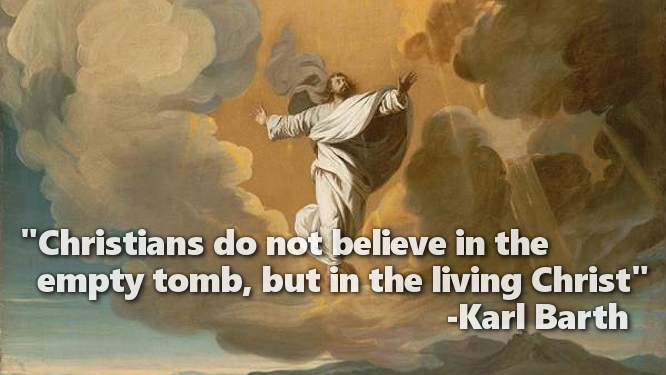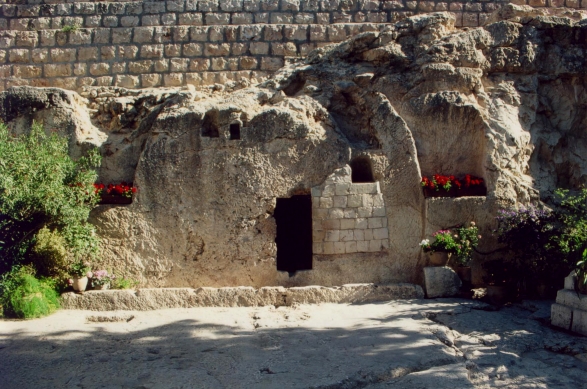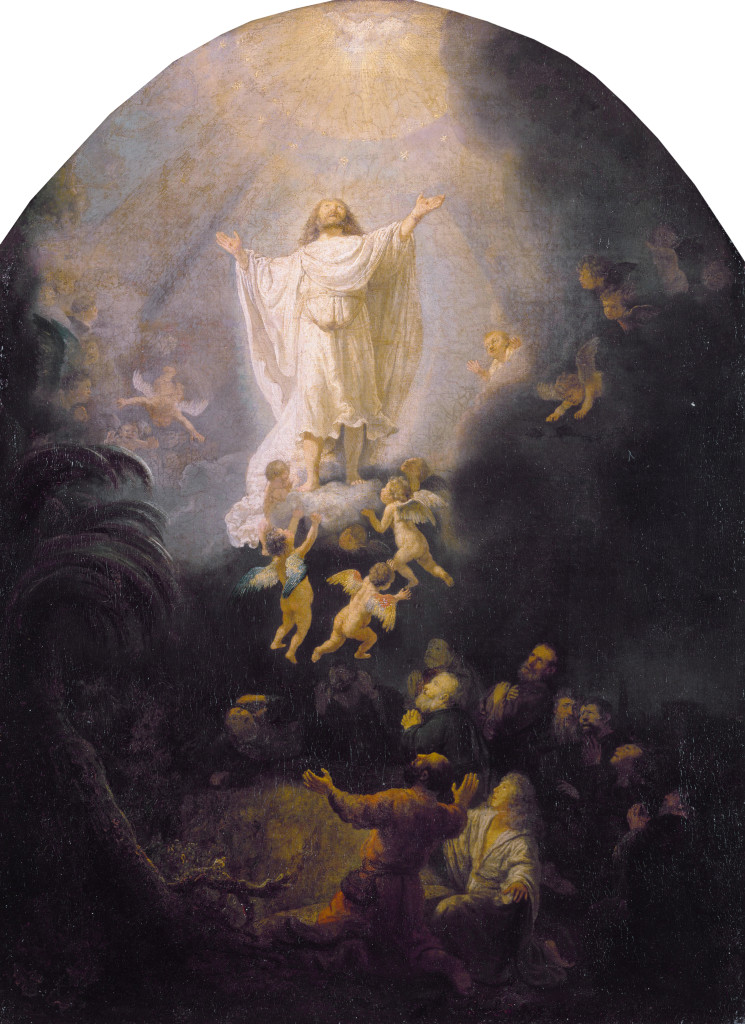 Jesus is Risen and the Tomb is Empty are often asserted together, but they are two distinct statements: Jesus is Risen is an article of faith but the Empty Tomb is a Passion narrative that may be demythologized. Barth explains the difference between these two statements when he says: "Christians do not believe in the empty tomb, but in the living Christ." Karl Barth is famous for affirming the historical Resurrection of Jesus, yet denying the historicity of the Empty Tomb. Unfortunately, this has caused people to wrongly believe that Barth denied the resurrection of Jesus at worst, or at best that he was merely rehearsing Rudolf Bultmann. Opponents of Barth have monopolized on this misunderstanding by providing terse summaries of Barth's commentary on the Empty Tomb that further misleads their readers. Therefore, to explain Barth's commentary on the Empty Tomb, I've provided an expanded the quotation from Barth's commentary on the Empty Tomb that includes his comparable assessment of the Ascension from The Church Dogmatics Vol. III.2.
Jesus is Risen and the Tomb is Empty are often asserted together, but they are two distinct statements: Jesus is Risen is an article of faith but the Empty Tomb is a Passion narrative that may be demythologized. Barth explains the difference between these two statements when he says: "Christians do not believe in the empty tomb, but in the living Christ." Karl Barth is famous for affirming the historical Resurrection of Jesus, yet denying the historicity of the Empty Tomb. Unfortunately, this has caused people to wrongly believe that Barth denied the resurrection of Jesus at worst, or at best that he was merely rehearsing Rudolf Bultmann. Opponents of Barth have monopolized on this misunderstanding by providing terse summaries of Barth's commentary on the Empty Tomb that further misleads their readers. Therefore, to explain Barth's commentary on the Empty Tomb, I've provided an expanded the quotation from Barth's commentary on the Empty Tomb that includes his comparable assessment of the Ascension from The Church Dogmatics Vol. III.2.
A Terse Summary of Karl Barth's Commentary on the Empty Tomb
Was there an empty tomb? Yes, this is the presupposition of the Resurrected Jesus. Were the Empty Tomb accounts in the Passion narratives Historical events? No, they are not meant to be understood as straight forward literal history that could be reconstructed. Not only is it impossible to harmonize the Empty Tomb narratives as verifiable history, and those who have attempted to harmonize these accounts have resulted in even more absurd results than problems they wished to overcome. If the Empty Tomb is a Legend or Saga or Myth, may it then be omitted from the New Testament? No, they are a necessary presuppositional sign of the Resurrected Jesus. What then is the Empty Tomb? It is a presuppositional sign of the Resurrected Jesus.
The Ascension compared to the Empty Tomb
Barth brilliantly couples his exegesis of the Ascension with the Empty Tomb. Once we admit that Jesus did not ascend to the right hand of the Father in same way as Iron Man or Superman lift off and embark on a flight into Outer Space, and admit that Heaven is not located up there somewhere above the sky or on the Dark Side of the Moon, then we are well poised to understand the Empty Tomb as a necessary and presuppositional sign of the Resurrected Jesus, and not read these accounts as if they were returning historical data that could be harmonized and filmed.
The Empty Tomb as Presuppositional Sign and Legend
We may assess the Empty Tomb in two ways: first as Presuppositional Sign and second as Legend. Barth affirms the importance of the empty tomb narratives, but not as historical events, but as presuppositional signs. This means that for a body to be resurrected, then the tomb must be empty, as a point of deduction or syllogism. The empty tomb as legend refers to the specific narratives in the Passion accounts that retell the historical events of the empty tomb. For instance, the tomb may be empty, even if the empty tomb narratives never happened as reported in the Passion accounts. Even if the empty tomb narratives prove to be legendary, this does not mean that they may be omitted or are superfluous, because they exist as a sign to the historical events, even if they themselves are a-historical.
Barth and Bultmann
Rudolf Bultmann is directly addressed at the head of the small print section containing the following extended quotation. Barth says, "Bultmann is splitting hairs when he calls the literal resurrection a 'nature-miracle'. Far from helping us understand it, this is merely an attempt to discredit it." (p15/[451]) and then writes, "None of the authors ever even dreamed, for example, of reducing the event to 'the rise of the Easter faith of the first disciples.'" (p[452]/16). These two quotations demonstrate the canyon separating Bultmann and Barth on the resurrection, a full and adequate comparison of Barth and Bultmann may be addressed in a later article.
Ten Karl Barth quotes on the Empty Tomb
1. "There is no sense in trying to visualize the ascension as a literal event, like going up in a balloon."
2. "[The Empty Tomb is] indispensable if we are to understand what the New Testament seeks to proclaim as the Easter message."
3. "Taken together, they mark the limits of the Easter period, at one end the empty tomb, and at the other the ascension."
4. "The content of the Easter witness, the Easter event, was not that the disciples found the tomb empty or that they saw Him go up to heaven"
5. "The content of the Easter witness [.. is], that when they had lost Him through death they were sought and found by Him as the Resurrected"
6. "It is the sign which obviates all possible misunderstanding. It cannot, therefore, but demand our assent, even as a legend."
7. "The point of the story is not that when Jesus left His disciples He visibly embarked upon a wonderful journey into space"
8. "Hence it [The Empty Tomb] is only the sign, although an indispensable sign."
9. "The achievements of Christian art in this field are amongst its worst perpetrations. But of course this is no reason why they should be used to make the whole things ridiculous."
10. "It still refers to the phenomenon ensuing the resurrection, to the presupposition of the appearance of Jesus."
Commentary on the Empty Tomb
I've divided this quotation from CD III.2 into three parts. The first is an introduction to the dual sign of the Empty Tomb and Ascension, and the second subsequent quotation is Barth's statements on the Empty Tomb, and the last and also subsequent quote is Barth's analogous comments on the Ascension. I've placed in bold a few sentences from it, to aid readers, and provided translations from the study edition of the original language text.
The Empty Tomb and the Ascension:
A few words may be said in conclusion about the empty tomb (Mk 16:1-8 and par.) and the ascension (Lk 24:50-53; Act 1:9-12). These stories are indispensable if we are to understand what the New Testament seeks to proclaim as the Easter message. Taken together, they mark the limits of the Easter period, at one end the empty tomb, and at the other the ascension. (It is worth noting that the limits are drawn not only backwards and forwards, but also downwards and upwards.) In the later apostolic preaching both events, like the Virgin Birth at the beginning of the Gospel narrative, seem to be presupposed, and are certainly never questioned, but they are only hinted at occasionally here and there, and never referred to explicitly. Even in the Easter narratives the empty tomb and the ascension are alike in the fact that they are both indicated rather than described; the one as an introduction, the other as a conclusion; the one a little more definitely, through still in very general terms, the other much more vaguely.
Indeed, in the strict sense the ascension occurs only in Acts 1:9f. It is not mentioned at all in the genuine Marcan ending (though this is obviously incomplete). In Matthew it is merely implied in the reference of Jesus to the power given Him in heaven and on earth (Mat 28:18). Luke's Gospel, according to the more probable reading at 24:51, is also very indefinite: he was parted from them, while in John it occurs only in the comprehensive to go up... and to go away, to be lifed up..., and glorified, which are used to embrace the whole ascent to Jerusalem, the crucifixion, the resurrection and the reappearance, and do not refer to the ascension as a concrete event. There are reasons for this. The content of the Easter witness, the Easter event, was not that the disciples found the tomb empty or that they saw Him go up to heaven, but that when they had lost Him through death they were sought and found by Him as the Resurrected. The empty tomb and the ascension are merely signs of the Easter event, just as the Virgin Birth is merely the sign of the nativity, namely, of the human generation and birth of the eternal Son of God. Yet both signs are so important that we can hardly say that they might equally well be omitted.
The Empty Tomb:
The function of the empty tomb, with its backward, downward, earthward reference, is to show that the Jesus who died and was buried was delivered from death, and therefore from the grave, by the power of God; that He, the Living, is not to be sought among the dead (Lk 24:5). "He is risen; he is not here: behold the place where they laid him" (Mk 16:6). "He is not here; for he is risen even as he said" (Mt 28:6; Lk 24:6). He is not here! But it is the angels who say this. Since the nativity and temptation the angels have not played any active part. But they now reappear at the tomb. And it is only the angels who say this; who as it were draw the line behind which there can be no going back. They only point to the empty tomb. The empty tomb was obviously a very ambiguous and contestable fact (Matt 27:62f; 28:11f). And what has happened around this sepulcher is a warning against making it a primary focus of attention.
The empty tomb is not the same thing as the resurrection. It is not the appearance of the Living; it is only its presupposition. Hence it is only the sign, although an indispensable sign. Christians do not believe in the empty tomb, but in the living Christ. This does not mean, however, that we can believe in the living Christ without believing in the empty tomb. Is it just a "legend"? What matter? It still refers to the phenomenon ensuing the resurrection, to the presupposition of the appearance of Jesus. It is the sign which obviates all possible misunderstanding. It cannot, therefore, but demand our assent, even as a legend. Rejection of the legend of the empty tomb has always been accompanied by rejection of the saga of the living Jesus, and necessarily so. Far better, then, to admit that the empty tomb belongs to the Easter event as its sign.
The Ascension:
The same considerations apply to the ascension. It is less directly attested in the New Testament, but unlike the empty tomb it has found a place in the creed, and has its own special feast in the Church Kalendar. In contrast to the first sign it points forward and upwards, thus serving a positive function. Just as the discovery of the empty tomb by the women marks the beginning of the Easter time and history, its end is marked by the meeting of the disciples on the mountain, which in Mat 28:16 is located in Galilee, but which Act 1:12 identifies with the Mount of Olives. The end consists in their in the same manner as you saw him go into heaven (Act 1:11). As the empty tomb looks downwards the ascension looks upwards. But again the ascension—Jesus' disappearance into heaven—is the sign of the Resurrected, not the Resurrected Himself. "Heaven" in biblical language is the sum of the inaccessible and incomprehensible side of the created world, so that, although it is not God Himself, it is the throne of God, the creaturely correspondence to his glory which is veiled from man, and cannot be disclosed except on His initiative. There is no sense in trying to visualize the ascension as a literal event, like going up in a balloon. The achievements of Christian art in this field are amongst its worst perpetrations. But of course this is no reason why they should be used to make the whole things ridiculous. The point of the story is not that when Jesus left His disciples He visibly embarked upon a wonderful journey into space, but that when He left them He entered the side of the created world which was provisionally inaccessible and incomprehensible, that before their eyes He ceased to be[sic] before their eyes. This does not mean, however, that He ceased to be a creature, man.
Barth, Karl. "Church Dogmatics Study Edition 16" Ed. T. F. Torrance and G.W. Bromiley. III.2 The Doctrine of Creation. Trans. G. W. Bromiley. London: T & T Clark, 2010. 17-8. Print. [p453-4]
Image sources included are all licensed under Public Domain via Wikimedia Commons:
- "Jesus ascending to heaven" by John Singleton Copley - abcgallery.com.
- The Garden Tomb in Jerusalem (source: wikipedia)
- "Resurrection of Christ and Women at the Tomb" by Fra Angelico (source: wikipedia)
- The Ascension, by Rembrandt (source: wikipedia)






March 15th, 2015 - 21:11
Great post! I found it very helpful. Thank you for sharing this with your readership.
The only thing I found a it confusing is the language of *sign.* I’m so used to hearing sign and seal when it comes to the sacraments for some reasons my mind would just go there as I read the post. I’m sure by sign in this case Barth mostly means that the empty tomb narratives point away from themselves to the Resurrected One;)
March 15th, 2015 - 23:12
“Sign and seal” may be more ‘sacramental’ than Barth intends in his use of “sign” or as such that John Calvin would intend in that phrase. Barth has more distance between what is the sign and that which is signified, such that in this usage, I believe Barth may be emphasizing the importance of the Resurrected Jesus, and the sign of the empty tomb is important, but should not be equated and identified with the Resurrected Jesus. However, maybe I can find an expert to weigh in on this!
June 18th, 2018 - 13:11
I am just learning about Barth’s theology, and don’t know if he has any intellectual contact with the American Pragmatists, but is the “sign” more in line with Charles Peirce’s semiotics?
March 28th, 2016 - 15:28
You can always count on a theologian to make things as clear as mud.
April 6th, 2016 - 21:05
Even Peter said Paul was hard to understand! Thanks for commenting! It’s fascinating stuff to ponder.
April 14th, 2017 - 10:09
This is why I like Pannenberg. 🙂
April 14th, 2017 - 14:23
Yes, this is why we need Pannenberg!
April 18th, 2020 - 04:05
Thanks! Clear and helpful on a difficult point.